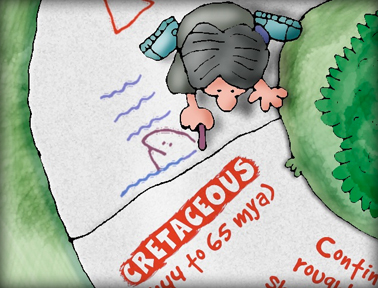A Walk Through Time
- June 11, 2014
- By Michael Kline
 Have you ever wished that you could take your students on a trip back through time? And I mean a real trip. Not simply a jaunt to 1980 when disco was all the rage, or to the 70’s when the terms “nehru jacket” and “platform shoes” meant something (resist the urge to dig out your high school Polaroids please). I’m talking about hundreds, thousands, millions, or even billions of years ago.
Have you ever wished that you could take your students on a trip back through time? And I mean a real trip. Not simply a jaunt to 1980 when disco was all the rage, or to the 70’s when the terms “nehru jacket” and “platform shoes” meant something (resist the urge to dig out your high school Polaroids please). I’m talking about hundreds, thousands, millions, or even billions of years ago.
Textbooks, tablets, and large-format content devices (we used to call them televisions) all offer a glimpse into what it was like in the days before Nixon, with most of those youth-marketed materials focusing on what the kids really want to know about; dinosaurs! And you can hardly blame the media for wanting to present a flurry of all-things-Jurassic, as junior paleontologists tend to gobble up those items faster than a squirrel at a bird feeder.
So, let’s do it.
Current estimates have the birth of our planet at somewhere around 4.6 billion years ago, and scientists measure that time using the Geologic Time Scale. Without going all H.G. Wells (author of The Time Machine, published in 1895) by suggesting that you and your students research, build, and use a device that defies the laws of physics, it might be a feat simplified by a tool that actually does have its origins in the distant past: Chalk, or sidewalk chalk to be more specific.
Considering that the geologic timeline of Earth is not a loop per se, but rather a linear process, we can say that it has a beginning and an end (now). Given this, the best way to fashion a timeline is outside the classroom, upon (what else) a sidewalk—hence the sidewalk chalk.
First, you’ll need to have some research in hand. The geologic time scale is roughly divided into four major eras–Precambrian, Paleozoic, Mesozoic, and Cenozoic. Those are further subdivided into periods. Rather than include all of that information here, you can either use a textbook or online resource as a guide, or you can allow the illustrator (ahem) to do most of the work for you. A model of the geologic time scale with annotations is available to download and print here.
With information in hand, choose a reference point, or a place for your “trip” to begin. My artwork is laid out in a circuitous manner, but you can use a straight sidewalk. Do a rough layout using the different periods and sub-periods as your guide, allowing extra space for your students to fill in with most of the details, such as flora and fauna, and major geologic points (volcanoes, mountains moving, and major extinctions). Have your pupils then go in and fill out the rest with the chalk.
Be sure to point out to the kids that modern humans don’t show up until the last 1.6 million years of the time scale, and use the acronym MYA (millions of years ago) to designate exactly how far into the past some of the events take place, as well as when certain types of animals and plants make their appearances.
Your entire class can be in on this project if you divide the duties among students who are good at finding pictures, doing the artwork (we all love THAT part), doing research, or just plotting the specific divisions. Sidewalk chalk works wonderfully in this case and will wash easily with the first rain. It’s also a great metaphor for the fleeting permanence of the earth’s history, as in how quickly it can fade, and how difficult it is to spot after the effects of time and weather. You don’t necessarily need to have the project entirely illustrated either. If your students would rather tape images into place along your Sidewalk Timeline Project, then by all means… Whatever encourages them to become engaged.
For more information on the geologic time scale and our planet in general, take a look at the Kids Discover issue of Earth.
And if you’re wondering, I did have a nehru jacket. You?
Teach. Learn. Enjoy!

Kids Discover Talks with Television Lighting Designer Christopher Landy About the Rockefeller Center Christmas Tree Lighting
- December 9, 2025

It’s the Most Wonderful Time of the Year… For Community Service Projects!
- December 8, 2025

The Rockefeller Center Christmas Tree Lights the 2025 Holiday Season in New York City
- December 3, 2025